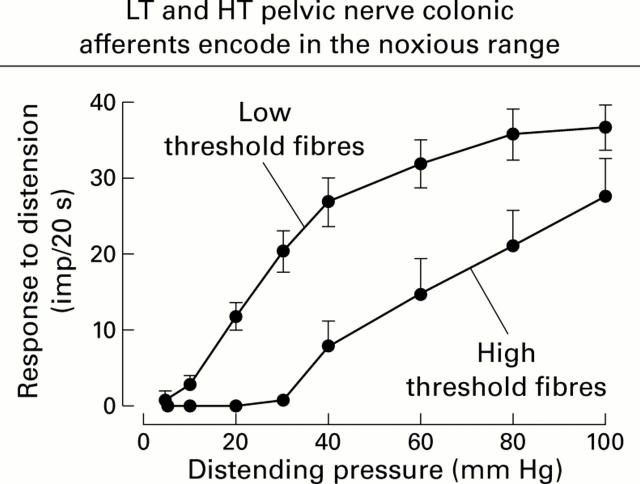Full Text
The Full Text of this article is available as a PDF (99.9 KB).
Figure 1 .
Representation of visceral sensory innervation of the gastrointestinal tract. The sensory innervation that anatomically exists in association with the sympathetic nervous system is shown on the left. These spinal visceral sensory fibres traverse both prevertebral (CG, coeliac ganglion, IMG, inferior mesenteric ganglion, SMG, superior mesenteric ganglion) and paravertebral ganglia en route to the spinal cord. Pelvic and vagus nerve innervation to the sacral spinal cord and brain stem, respectively, is shown on the right. (Modified from Sengupta and Gebhart.1)
Figure 2 .
Mechanosensitive pelvic nerve sensory fibres that innervate the urinary bladder or distal colon have low (<5 mm Hg) or high (>30 mm Hg) thresholds for response to distension. Both low (LT) and high (HT) threshold sensory fibres encode the distending pressure well into the noxious range (>40 mm Hg). (Modified from Sengupta and Gebhart.3)
Figure 3 .
Illustration of the presence of visceral hyperalgesia in patients with irritable bowel syndrome (IBS). (Modified from Ritchie.5)
Figure 4 .
Visceral sensory fibres sensitise to experimental organ inflammation. In this example, responses of a high threshold pelvic nerve sensory fibre are shown before (control) and 30 minutes after intracolonic instillation of 2.5% acetic acid (inflamed). Note that response magnitude to distension (bottom) increases after inflammation and that response threshold decreases from about 30 to 10 mm Hg.
Figure 5 .
Example of a mechanically insensitive (silent) pelvic nerve sensory fibre. Before intracolonic instillation of the C fibre excitant mustard oil, this fibre did not respond to 100 mm Hg colonic distension (CRD) (not shown). After mustard oil treatment, the fibre began to discharge and acquired sensitivity to CRD. (Modified from Sengupta and Gebhart.1)
Selected References
These references are in PubMed. This may not be the complete list of references from this article.
- Mayer E. A., Gebhart G. F. Basic and clinical aspects of visceral hyperalgesia. Gastroenterology. 1994 Jul;107(1):271–293. doi: 10.1016/0016-5085(94)90086-8. [DOI] [PubMed] [Google Scholar]
- Ness T. J., Gebhart G. F. Visceral pain: a review of experimental studies. Pain. 1990 May;41(2):167–234. doi: 10.1016/0304-3959(90)90021-5. [DOI] [PubMed] [Google Scholar]
- Ritchie J. Pain from distension of the pelvic colon by inflating a balloon in the irritable colon syndrome. Gut. 1973 Feb;14(2):125–132. doi: 10.1136/gut.14.2.125. [DOI] [PMC free article] [PubMed] [Google Scholar]







